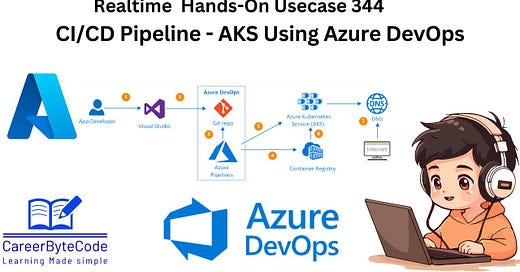Mastering CI/CD: Deploy Microservices to Azure Kubernetes Service (AKS) Like a Pro
A microservices CI/CD pipeline with AKS and Helm helps organizations deploy applications efficiently while maintaining consistency and reliability.
1. Problem Description
A team needs an automated CI/CD pipeline to build, test, and deploy microservices-based applications to Azure. This pipeline should include computerised tests, linting, and deployment on Azure Kubernetes Service (AKS).
Scenario
Set up a CI/CD pipeline in Azure DevOps.
Implement Docker-based build pipelines for microservices.
Use Kubernetes to deploy the services to AKS.
Integrate automated testing in the pipeline.
Tools or Services Needed
Azure DevOps Pipelines
Docker
Kubernetes (kubectl)
Azure Kubernetes Service (AKS)
Helm
2. Why We Need This Use Case
A microservices CI/CD pipeline with AKS and Helm helps organizations deploy applications efficiently while maintaining consistency and reliability. It enables:
Automated testing, linting, and deployment.
Faster feature delivery with improved quality.
Standardized deployment for multiple microservices.
Scalability using Kubernetes' self-healing and scaling features.
Environment parity to eliminate configuration drift.
In modern software development, microservices architecture is widely adopted due to its scalability, modularity, and ease of deployment. However, manually deploying and managing microservices on Kubernetes can be time-consuming and error-prone.
A CI/CD (Continuous Integration/Continuous Deployment) pipeline automates the entire software release process, ensuring rapid and reliable application deployment to Azure Kubernetes Service (AKS). This use case focuses on setting up a fully automated CI/CD pipeline using Azure DevOps, enabling developers to:
Automate code integration, testing, and deployment.
Achieve zero-downtime deployments using rolling updates.
Reduce human errors in deployment processes.
Maintain version control and rollback mechanisms.
Improve DevOps efficiency and developer productivity.
3. When We Need This Use Case
When managing a microservices-based architecture with independent services.
When frequent, automated deployments are required with minimal downtime.
When deploying applications across different environments (dev, test, staging, production).
When utilizing Kubernetes for its scaling, reliability, and orchestration.
This use case is crucial in scenarios such as:
✅ Rapid Feature Releases – When development teams frequently push updates and require a streamlined deployment mechanism.
✅ Scalability Demands – When applications must scale dynamically to handle fluctuating user traffic.
✅ DevOps & Automation Adoption – When organizations want to implement DevOps best practices for software delivery.
✅ Disaster Recovery & Rollbacks – When maintaining multiple versions of microservices with rollback capabilities is necessary.
✅ Consistency Across Environments – When ensuring uniform deployments across development, testing, staging, and production environments.
✅ Compliance & Security – When organizations need to enforce security policies in the deployment pipeline.
4. Challenge Questions
Keep reading with a 7-day free trial
Subscribe to CareerByteCode’s Substack to keep reading this post and get 7 days of free access to the full post archives.






